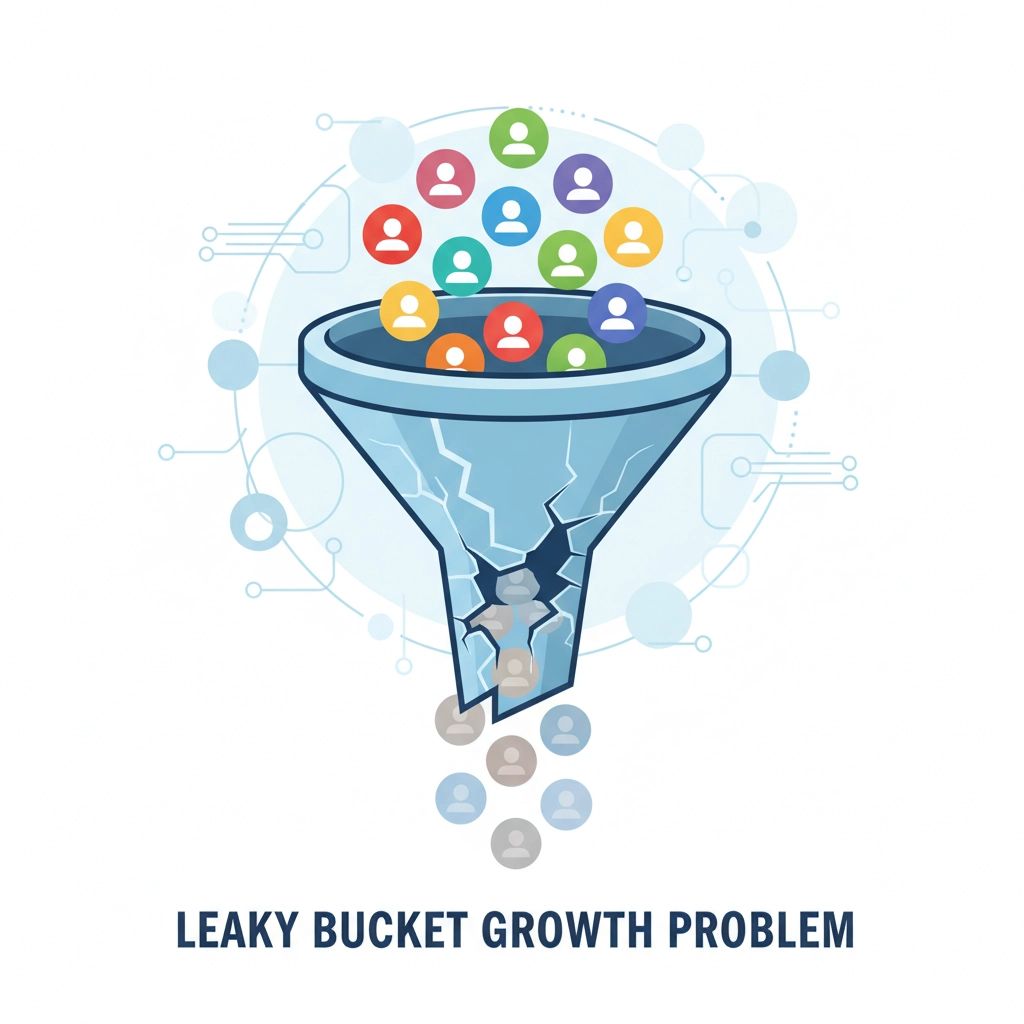When Traction Backfires: What to Do When Your Startup's Momentum is Working Against You
Oct 29, 2025
You've been there. The metrics look good. User signups are climbing. Revenue is trending up. Your board deck shows those beautiful hockey stick charts everyone loves to see.
Then something shifts. Key team members start asking harder questions in meetings. Investors who were once eager to talk begin taking longer to respond. Your best customers seem less engaged. The momentum that felt unstoppable just months ago now feels like it's working against you.
Here's what most deeptech and healthtech founders don't realize: traction can be your biggest enemy when it's pointing you in the wrong direction.
The Silence That Should Scare You
In my Deeptech Insider Issue #34, I shared a story that haunts me: "The Moment My Founders Went Silent." It wasn't when the metrics crashed that I knew we were in trouble. It was when the founders: brilliant, vocal, passionate people: suddenly had nothing to say in our strategy calls.
They had traction. Lots of it. But they'd gone silent because they realized their momentum was carrying them toward a cliff, not a summit.
This happens more often than you think. Especially in deeptech and healthtech, where the gap between "impressive metrics" and "sustainable business model" can be enormous.

The Three Ways Traction Backfires
1. The Negative Momentum Spiral
When your growth stalls: even briefly: you enter what I call the negative momentum loop. This isn't a linear decline; it's exponential.
First, recruiting becomes harder. The best talent gravitates toward companies with clear momentum. Your time-to-hire increases, and conversion rates drop because candidates have better options.
Then your current team starts looking around. They joined because they saw growth opportunities. When momentum stalls, retention suffers, and you lose the people you most need to keep.
Finally, fundraising becomes exponentially more difficult. Investors can smell momentum loss from across the valley. The capital you need to invest in new initiatives and pivot strategies becomes harder to secure, creating a vicious cycle.
For deeptech startups, this spiral is particularly brutal because your technology development cycles are longer. You can't pivot as quickly as a software company when momentum shifts.
For healthtech companies, regulatory timelines mean that momentum loss can be fatal. If you lose key team members during a clinical trial or FDA review process, recovery can take years.
2. The Growth-Without-Foundation Trap
This is where your acquisition numbers look fantastic, but your retention metrics tell a different story. You're adding customers faster than you can keep them engaged, creating what I call "leaky bucket growth."
In healthtech, this often manifests as impressive pilot program signups that never convert to full implementations. Hospitals and health systems are eager to test new technologies, but if your solution doesn't integrate smoothly into their existing workflows, those pilots become dead ends.
In deeptech, it might look like strong interest from enterprise clients who love your technology in theory but struggle to implement it at scale. Your sales team celebrates each new contract, but your customer success team is drowning in support tickets and churn warnings.
3. The Product-Market Fit Mirage
The most insidious form of traction backfire happens when you have satisfied customers and a working product, but you can't achieve sustainable, scalable growth.
This is common in both deeptech and healthtech because these sectors often start with a narrow, specific use case. You solve one problem really well for a small group of customers. The traction looks good within that niche, but when you try to expand, you hit walls.
Your deeptech solution might work perfectly for aerospace companies but struggle to adapt to automotive applications. Your healthtech platform might be ideal for cardiology practices but fail to translate to other specialties.

The Traction Audit Framework
Before you can fix traction that's working against you, you need to diagnose what's actually happening. Here's the audit framework I use with founders:
The Foundation Check
- Customer Satisfaction vs. Customer Growth: Are your existing customers genuinely happy, or just politely engaged?
- Team Energy vs. Team Output: Is your team working harder but accomplishing less?
- Investor Enthusiasm vs. Investor Questions: Are investors asking different questions than they were six months ago?
The Direction Check
- Revenue Quality: Is your revenue growing because you're solving bigger problems or because you're discounting to close deals?
- Market Feedback: Are prospects excited about your roadmap or asking why you don't already have features your competitors offer?
- Resource Allocation: Are you spending more time and money to achieve the same results?
The Sustainability Check
- Competitive Positioning: Are you still differentiated, or are you starting to compete on price?
- Talent Attraction: Are you attracting the people you need for your next phase, or settling for who you can get?
- Strategic Options: Do you have multiple paths forward, or are you locked into one increasingly difficult route?

The Recalibration Action Plan
Once you've identified that your traction is working against you, here's how to recalibrate:
Step 1: Stop the Bleeding (Week 1-2)
- Pause non-essential growth initiatives. If you're in a negative momentum spiral, throwing more resources at growth will only accelerate the decline.
- Have honest conversations with your team. The silence that scares me isn't when founders don't know what to say to investors: it's when they don't know what to say to their own people.
- Assess your cash runway with your new reality. If growth is slowing or becoming more expensive, your funding timeline changes dramatically.
Step 2: Diagnose the Root Cause (Week 2-4)
- Customer interviews: Not surveys, not metrics analysis: actual conversations with your best and worst customers.
- Team feedback sessions: Your people are closer to the operational reality than you are. Ask them where they see friction and waste.
- Competitive analysis: Has the landscape shifted while you were focused on growth metrics?
Step 3: Choose Your Recalibration Strategy (Week 4-6)
For deeptech founders: You typically have three options:
- Technology pivot: Adapt your core technology for a different application
- Market pivot: Take your current solution to a completely different industry
- Business model pivot: Change how you monetize your technology
For healthtech founders: Your options often include:
- Care setting pivot: Move from hospitals to clinics, or from primary care to specialty care
- User pivot: Shift from clinician-facing to patient-facing, or vice versa
- Integration pivot: Instead of competing with existing systems, become part of them
Step 4: Test and Validate (Week 6-12)
- Small-scale experiments: Before you announce a major pivot, test your new direction with a subset of customers or prospects.
- Team alignment: Make sure everyone understands not just what you're changing, but why you're changing it.
- Investor communication: Keep your investors informed about your process, not just your results.

Warning Signs to Watch For
Here are the early indicators that your traction might be working against you:
For Deeptech Startups:
- Your biggest customers are asking for features that move you away from your core technology advantage
- Sales cycles are getting longer despite more market awareness
- Your technical team is spending more time on customization than innovation
- Competitors with simpler solutions are winning deals you "should" win
For Healthtech Startups:
- Pilot programs aren't converting to full implementations
- Your clinical champions are struggling to get organizational buy-in
- Integration timelines keep extending due to "technical complexities"
- Your health outcomes data is strong, but your business outcomes data is weak
Universal Warning Signs:
- Team meetings feel more like problem-solving sessions than strategy sessions
- You're celebrating lagging indicators while ignoring leading indicators
- Your best people are asking questions about the company's direction
- Investors are asking more detailed questions about unit economics and retention
The Path Forward
Traction that works against you isn't a death sentence: it's a recalibration signal. The founders who thrive in deeptech and healthtech aren't the ones who never hit these moments. They're the ones who recognize them quickly and act decisively.
Sometimes that means slowing down to speed up. Sometimes it means changing direction entirely. But it always means having the courage to acknowledge when your current path isn't sustainable, even when the short-term metrics look good.

The most successful founders I work with have learned to treat momentum as a tool, not a goal. They understand that the right kind of traction: sustainable, scalable, aligned with market needs: is worth more than impressive growth numbers that lead nowhere.
If you're feeling that uncomfortable silence in your own strategy sessions, if your team's energy doesn't match your growth metrics, or if you're working harder than ever but moving forward slower than ever, it might be time for a traction audit.
Ready to turn your momentum challenges into strategic advantages? Join hundreds of deeptech and healthtech founders who are building sustainable, scalable businesses with clear strategic direction. Get access to our founder resources and community.